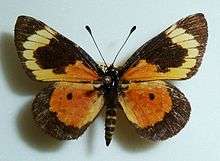Cooksonia neavei
Cooksonia neavei, or Neave's tiger mimic, is a butterfly in the family Lycaenidae. The species was first described by Hamilton Herbert Druce in 1912.[1] It is found in Tanzania, Zambia and Zimbabwe.[2] The habitat consists of Brachystegia woodland.
| Neave's tiger mimic | |
|---|---|
 | |
| C. n. rhodesiae | |
| Scientific classification | |
| Kingdom: | |
| Phylum: | |
| Class: | |
| Order: | |
| Family: | |
| Genus: | |
| Species: | C. neavei |
| Binomial name | |
| Cooksonia neavei (H. H. Druce, 1912) | |
| Synonyms | |
| |
Adults resemble dead leaves. They are on wing from late October to mid-November.
The larvae feed on foliose lichens, probably Parmelia species that grow on tree trunks,[3] as is the case with C. aliciae in Malawi.
Subspecies
- Cooksonia neavei neavei (southern Tanzania)
- Cooksonia neavei rhodesiae Pinhey, 1962 (north-eastern Zimbabwe, Zambia)
gollark: Don't <:fern:492394921827893250> it up, just do it!
gollark: <:fern:492394921827893250> <:fern:492394921827893250> <:fern:492394921827893250>
gollark: Just add a facepalm one.
gollark: Keep the old fern one please.
gollark: <:fern:492394921827893250>
References
| Wikimedia Commons has media related to Cooksonia neavei. |
| Wikispecies has information related to Cooksonia neavei |
- Savela, Markku (August 29, 2016). "Cooksonia neavei (Druce, 1912)". Lepidoptera and Some Other Life Forms. Retrieved December 16, 2019.
- "Afrotropical Butterflies: Lycaenidae - Subtribe Mimacraeina". Archived from the original on 2013-09-27. Retrieved 2012-10-01.
- Dickson, C.G.C.; et al. (1978). Pennington's Butterflies of Southern Africa. Johannesburg: Ad. Donker. p. 83. ISBN 0-949937-48-7.
This article is issued from Wikipedia. The text is licensed under Creative Commons - Attribution - Sharealike. Additional terms may apply for the media files.